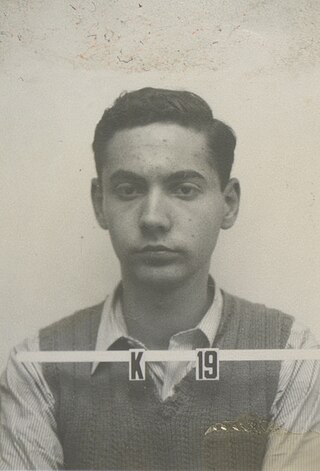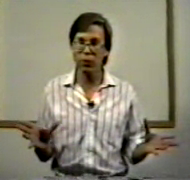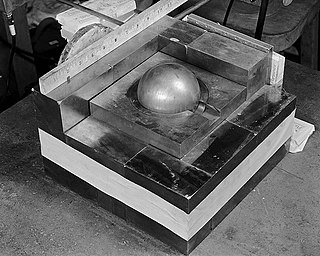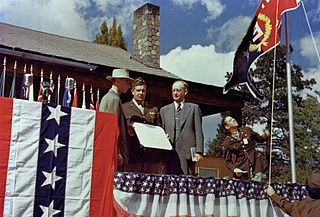
Edward Teller was a Hungarian American theoretical physicist who is known colloquially as "the father of the hydrogen bomb" and one of the creators of the Teller–Ulam design. Teller was known for his scientific ability and his difficult interpersonal relations and volatile personality.

Los Alamos National Laboratory is one of the sixteen research and development laboratories of the United States Department of Energy (DOE), located a short distance northwest of Santa Fe, New Mexico, in the American southwest. Best known for its central role in helping develop the first atomic bomb, LANL is one of the world's largest and most advanced scientific institutions.

Stanisław Marcin Ulam was a Polish-American mathematician and nuclear physicist. He participated in the Manhattan Project, originated the Teller–Ulam design of thermonuclear weapons, discovered the concept of the cellular automaton, invented the Monte Carlo method of computation, and suggested nuclear pulse propulsion. In pure and applied mathematics, he proved some theorems and proposed several conjectures.

Theodore Alvin Hall was an American physicist and an atomic spy for the Soviet Union, who, during his work on United States efforts to develop the first and second atomic bombs during World War II, gave a detailed description of the "Fat Man" plutonium bomb, and of several processes for purifying plutonium, to Soviet intelligence. His brother, Edward N. Hall, was a rocket scientist who led the U.S. Air Force's program to develop an intercontinental ballistic missile, personally designing the Minuteman missile and convincing the Pentagon and President Eisenhower to adopt it as a key part of the nation's strategic nuclear triad.

Robert Scott Lazar is an American businessman and conspiracy theorist who claims he was hired in the late 1980s to reverse-engineer extraterrestrial technology. This work supposedly occurred at a secret site called "S-4", a subsidiary installation allegedly located several kilometers south of the United States Air Force facility popularly known as Area 51.

Richard Lee Rhodes is an American historian, journalist, and author of both fiction and non-fiction, including the Pulitzer Prize-winning The Making of the Atomic Bomb (1986), and most recently, Energy: A Human History (2018).
Lincoln Child is an American author of techno-thriller and horror novels. Though he is most well known for his collaborations with Douglas Preston, he has also written seven solo novels, including the Jeremy Logan series. Over twenty of the collaborative novels and most of his solo novels have become New York Times bestsellers, some reaching the #1 position. Child and Preston's first novel together, Relic, was adapted into a feature film. Their books are notable for their thorough research and scientific accuracy.
Douglas Jerome Preston is an American journalist and author. Although he is best known for his thrillers in collaboration with Lincoln Child, he has also written six solo novels, including the Wyman Ford series and a novel entitled Jennie, which was made into a movie by Disney. He has authored a half-dozen nonfiction books on science and exploration and writes occasionally for The New Yorker, Smithsonian, and other magazines.

Atomic spies or atom spies were people in the United States, the United Kingdom, and Canada who are known to have illicitly given information about nuclear weapons production or design to the Soviet Union during World War II and the early Cold War. Exactly what was given, and whether everyone on the list gave it, are still matters of some scholarly dispute. In some cases, some of the arrested suspects or government witnesses had given strong testimonies or confessions which they recanted later or said were fabricated. Their work constitutes the most publicly well-known and well-documented case of nuclear espionage in the history of nuclear weapons. At the same time, numerous nuclear scientists wanted to share the information with the world scientific community, but this proposal was firmly quashed by the United States government. It is worth noting that many scientists who worked on the Manhattan Project were deeply conflicted about the ethical implications of their work, and some were actively opposed to the use of nuclear weapons.

The Los Alamos Primer is a printed version of the first five lectures on the principles of nuclear weapons given to new arrivals at the top-secret Los Alamos laboratory during the Manhattan Project. The five lectures were given by physicist Robert Serber in April 1943. The notes from the lectures which became the Primer were written by Edward Condon.

Atomic tourism or nuclear tourism is a recent form of tourism in which visitors learn about the Atomic Age by traveling to significant sites in atomic history such as nuclear test reactors, museums with nuclear weapon artifacts, delivery vehicles, sites where atomic weapons were detonated, and nuclear power plants.

The Making of the Atomic Bomb is a history book written by the American journalist and historian Richard Rhodes, first published by Simon & Schuster in 1987. The book won multiple awards, including Pulitzer Prize for General Non-Fiction. The narrative covers people and events from early 20th century discoveries leading to the science of nuclear fission, through the Manhattan Project and the atomic bombings of Hiroshima and Nagasaki.

The demon core was a sphere of plutonium that was involved in two fatal radiation accidents when scientists tested it as a fissile core of an early atomic bomb. It was manufactured by the Manhattan Project, the U.S. nuclear weapon development effort during World War II. It was a subcritical mass that weighed 6.2 kilograms (14 lb) and was 89 millimeters (3.5 in) in diameter.
Jennet Conant is an American non-fiction author and journalist. She has written five books about World War II, three of which have appeared on the New York Times Best Seller list: Tuxedo Park: A Wall Street Tycoon and the Secret Palace of Science that Changed the Course of WWII, 109 East Palace: Robert Oppenheimer and the Secret City of Los Alamos, The Irregulars: Roald Dahl and the British Spy Ring in Wartime Washington, and A Covert Affair: Julia Child and Paul Child in the OSS.

Gideon's Sword is a novel by Douglas Preston and Lincoln Child. It was released on February 22, 2011 by Grand Central Publishing. The book is the first installment in the Gideon Crew series.

Myrtle Claire Bachelder was an American chemist and Women's Army Corps officer, who is noted for her secret work on the Manhattan Project atomic bomb program, and for the development of techniques in the chemistry of metals.

Darol Kenneth Froman was the deputy director of the Los Alamos National Laboratory from 1951 to 1962. He served as a group leader from 1943 to 1945, and a division head from 1945 to 1948. He was the scientific director of the Operation Sandstone nuclear tests at Enewetak Atoll in the Pacific in 1948, and assistant director for weapons development from 1949 to 1951.

Operation Dominic was a series of 31 nuclear test explosions with a 38.1 Mt (159 PJ) total yield conducted in 1962 by the United States in the Pacific. This test series was scheduled quickly, in order to respond in kind to the Soviet resumption of testing after the tacit 1958–1961 test moratorium. Most of these shots were conducted with free fall bombs dropped from B-52 bomber aircraft. Twenty of these shots were to test new weapons designs; six to test weapons effects; and several shots to confirm the reliability of existing weapons. The Thor missile was also used to lift warheads into near-space to conduct high-altitude nuclear explosion tests; these shots were collectively called Operation Fishbowl.

The Los Alamos Laboratory, also known as Project Y, was a secret laboratory established by the Manhattan Project and operated by the University of California during World War II. Its mission was to design and build the first atomic bombs. Robert Oppenheimer was its first director, serving from 1943 to December 1945, when he was succeeded by Norris Bradbury. In order to enable scientists to freely discuss their work while preserving security, the laboratory was located in a remote part of New Mexico. The wartime laboratory occupied buildings that had once been part of the Los Alamos Ranch School.

Beyond The Ice Limit is a techno-thriller novel by American authors Douglas Preston and Lincoln Child. The book is a sequel to their 2000 book The Ice Limit and was published on May 17, 2016 by Grand Central Publishing. It is the fourth book in Preston and Child's Gideon Crew series.

















